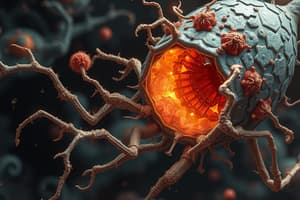Podcast
Questions and Answers
Which cells are responsible for engulfing apoptotic bodies?
Which cells are responsible for engulfing apoptotic bodies?
- Phagocytic cells (correct)
- Neurons
- Muscle cells
- Red blood cells
Which marker on apoptotic cells signals phagocytic cells to begin engulfment?
Which marker on apoptotic cells signals phagocytic cells to begin engulfment?
- Phosphatidylserine (correct)
- Fibronectin
- Cholesterol
- Integrins
Which enzyme is responsible for translocating phosphatidylserine to the outer membrane leaflet?
Which enzyme is responsible for translocating phosphatidylserine to the outer membrane leaflet?
- ATPase
- Helicase
- Scramblase (correct)
- Flippase
Which cytokines are released by phagocytic cells to inhibit inflammation?
Which cytokines are released by phagocytic cells to inhibit inflammation?
What role does the p53 protein play in apoptosis?
What role does the p53 protein play in apoptosis?
What type of process is necrosis?
What type of process is necrosis?
Which characteristic is associated with apoptosis?
Which characteristic is associated with apoptosis?
What is a significant outcome of necrosis?
What is a significant outcome of necrosis?
What triggers the process of necrosis?
What triggers the process of necrosis?
How is the timeline of apoptosis different from necrosis?
How is the timeline of apoptosis different from necrosis?
What activates the apoptosis suicide program?
What activates the apoptosis suicide program?
Which phospholipid flips to the cell surface during apoptosis?
Which phospholipid flips to the cell surface during apoptosis?
What is the role of cytochrome c in apoptosis?
What is the role of cytochrome c in apoptosis?
What happens to the plasma membrane during apoptosis?
What happens to the plasma membrane during apoptosis?
What are apoptotic bodies and how are they dealt with?
What are apoptotic bodies and how are they dealt with?
Flashcards are hidden until you start studying
Study Notes
Apoptosis
- Programmed cell death that is active and physiological, ensuring cells live only when and where needed.
- Deprivation of survival factors activates the suicide program.
Apoptosis Characteristics
- Cell shrinkage occurs, but cells do not lyse, and plasma membrane remains intact.
- Blebbing occurs, where portions of the plasma membrane bud off.
- Phosphatidylserine in the inner membrane phospholipid flips to the cell surface, serving as an "eat-me" signal to phagocytic cells.
- Mitochondria releases cytochrome c in an ATP-dependent process, but remains within blebs.
- Chromatin segments and condenses.
Apoptosis Characteristic
- Apoptotic bodies are formed from apoptotic cells and engulfed by phagocytic cells (e.g., macrophages, dendritic cells).
Necrosis
- Passive, pathological process induced by acute injury or disease.
- Characteristics:
- Affects groups of cells in a localized region simultaneously.
- Cells increase in volume and lyse (burst).
- Release of intracellular contents, including mitochondria.
- Often induces a damaging inflammatory response.
- Necrotic process completes within several days.
Apoptosis vs. Necrosis
- Apoptosis is an active, physiological process that occurs individually, within a few hours.
- Necrosis is a passive, pathological process that affects groups of cells, completing within several days.
Apoptosis Characteristic
- Apoptotic bodies are recognized for engulfment by the presence of phosphatidylserine.
- Scramblase removes the membrane phospholipids phosphatidylserine from the inner membrane leaflet.
- Phagocytic cells also release cytokines, including interleukin-10 (IL-10) and transforming growth factor (TGF-β), that inhibit inflammation.
- Apoptosis is completed within a few hours.
Biological Significance of Apoptosis
1. Removal of Damaged Cells
- Removes cells damaged beyond repair, infected, or starved, saving nutrition and preventing viral spread.
- p53 protein halts cell cycle and stimulates apoptosis.
2. During Development
- Extensive cell division and differentiation during embryonic development often result in excess cells, which are removed through apoptosis.
Studying That Suits You
Use AI to generate personalized quizzes and flashcards to suit your learning preferences.


